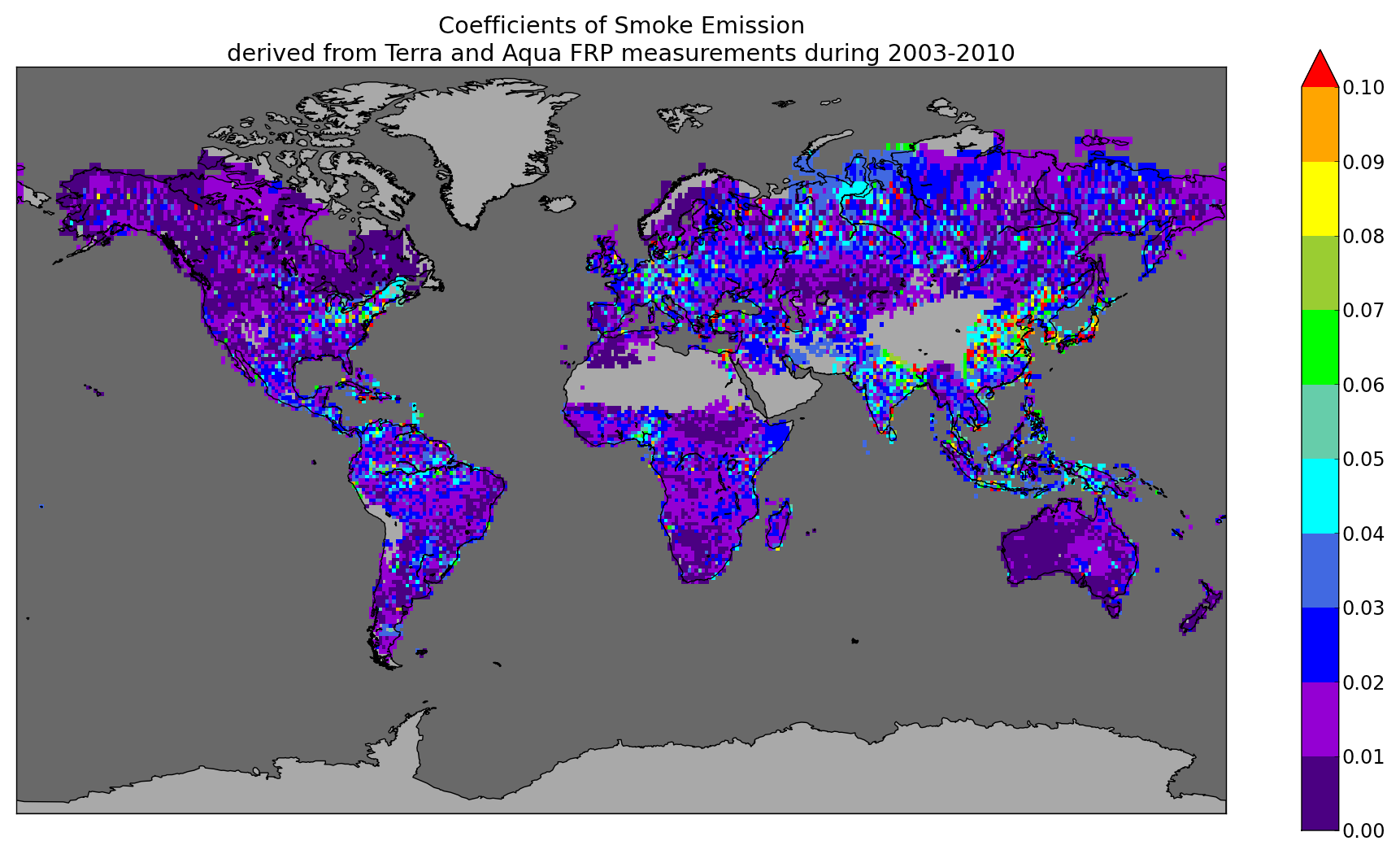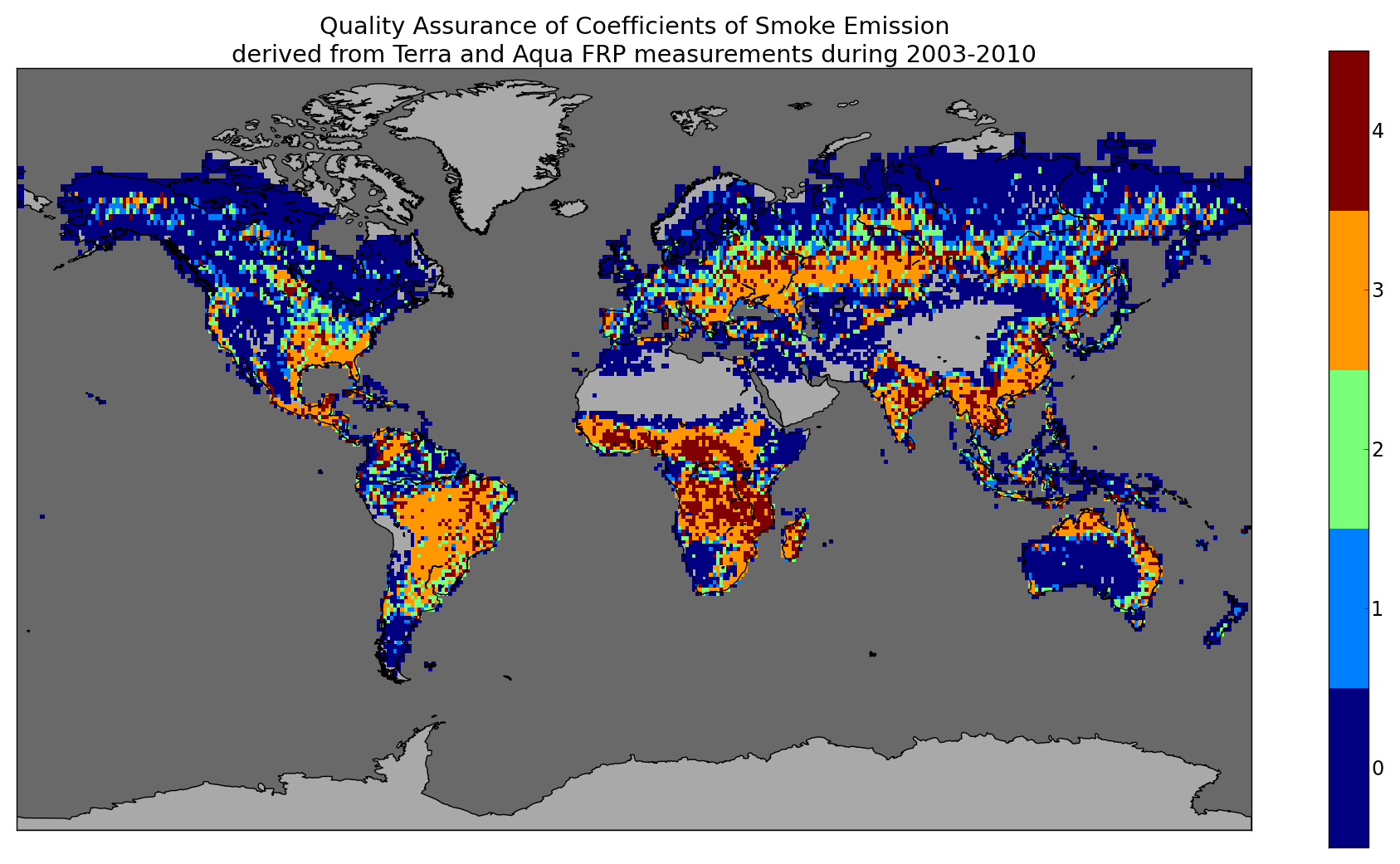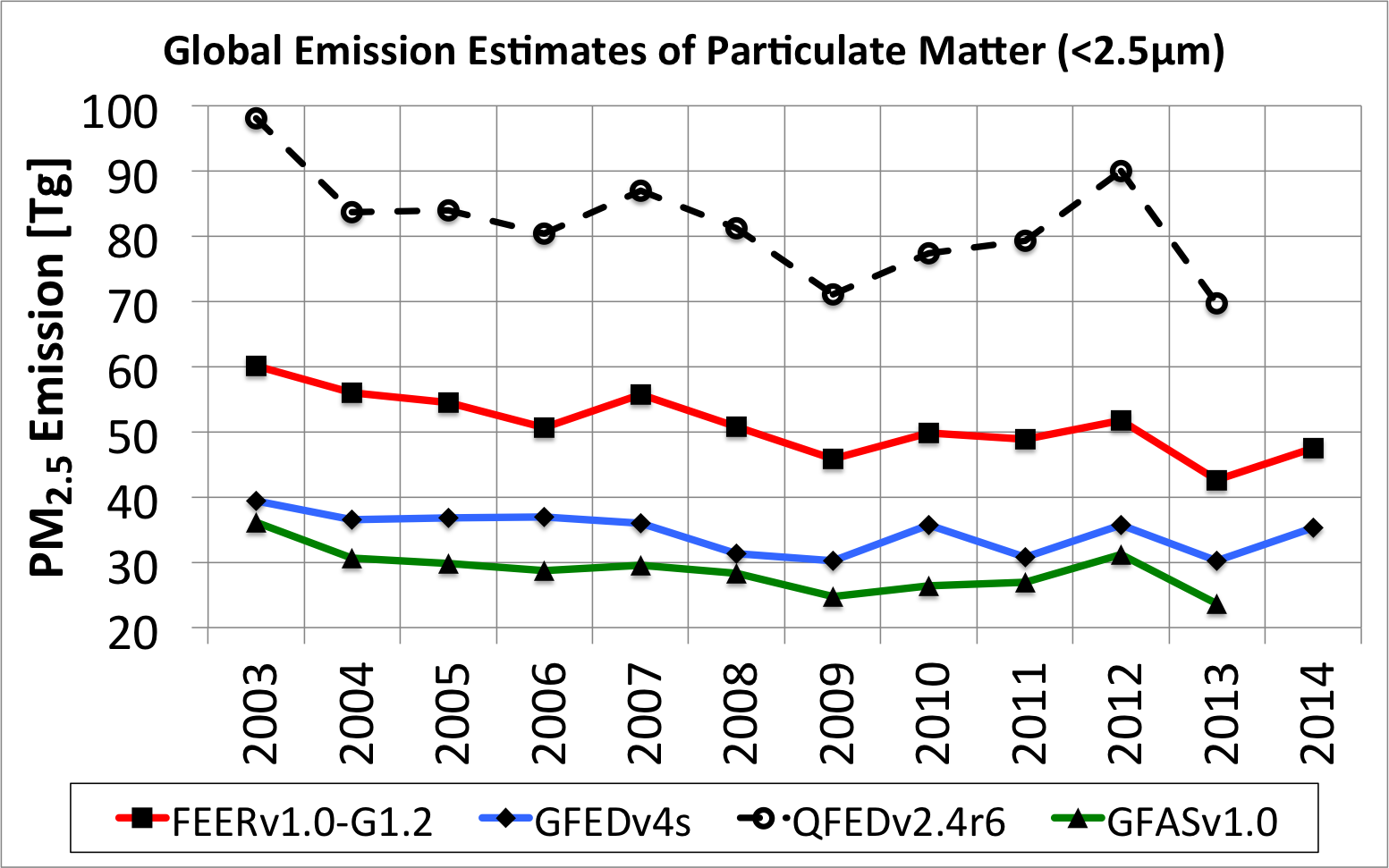National Aeronautics and Space Administration
Goddard Space Flight Center

Fire Energetics and Emissions Research
FEER Updates

20.Feb.2019 - VIIRS active fire data available as VNPFIRE product.
12.Feb.2019 - FEERv1.0 Emissions processing stream fixed.
08.Feb.2019 - MODFIRE processing stream fixed.
31.Jul.2018 - Suomi-NPP VIIRS fire data added to Africa Explorer.
Smoke Aerosol Emission Coefficients
Welcome to the FEER Ce and Emissions product page!!
FEERv1.0 Ce is the first publically available version of the coefficient of emission (Ce, in kg/MJ) product by the FEER project group. Emissions rates (Rsa) or emissions (Msa) are directly related to Ce by, Rsa = Ce * FRP and Msa = Ce * FRE where FRP is fire radiative power and its temporal integral, FRE, is fire radiative energy. Version 1.0 of FEER Ce is specifically for the conversion between FRE and emissions of total particulate matter (TPM). This product was derived using coupled MODIS fire and aerosol measurements. More...
Quick-view images


FEERv1.0 Ce Product Files
This product is provided "as-is" and without user-support services. Be sure to read the documentation for a sufficient understanding of the product and for instructions of how to use it. For information regarding the actual algorithm, see the corresponding project page for details.This product is freely provided to the public, but we request that you inform us when you incorporate this product into your own research and publications. Thank you!
*** Please cite the corresponding journal article (see below). You can join our mailing list if you'd like to stay informed on FEER emissions product progress, or else you can subscribe to the RSS feed for the FEER site. Remember to inform us when you use this product in your own research and publications. Thank you! ***
Generating Emissions
Ce is an intermediate variable used to convert fire energy to emissions - typically the desired end result. This equation relating FRP or FRE to emissions is stated at the top of this page and described in detail in the documentation: simply multiply your fire energy data against our Ce product to derive your emissions. However, most users will admittedly not have their own FRP or FRE product from which to generate their own emissions output, and this fact is fully understood.
For those users who do not have their own source of FRP or FRE needed for their particular application, the following are non-exhaustive lists of such documented products:
| Platform Type | Instrument / Product |
|---|---|
| Aircraft | AMS MAS MASTER |
| LEO Satellites | MODIS* VIIRS** |
| GEO Satellites | LSA SAF* WFABBA* |
| Documentation | Spatial Extent | FRP Data Source Instruments | FRE Data Set Link |
|---|---|---|---|
| Kaiser et al. 2012 | global | MODIS | [link] |
| Roberts et al. 2005 & 2008 | Africa | SEVIRI, MODIS | |
| Vermote et al. 2009 | global | MODIS, SEVIRI, TRMM VIRS | |
| Freeborn et al. 2009 & 2011 | Africa | SEVIRI, MODIS | |
| Zhang et al. 2012 | global | GEO satellites |
FEERv1.0 Emissions Product Files
For those users who would rather have access to a finished emissions product, we have taken on the task of generating one set of global emissions products using FEERv1.0 Ce with FRP data from the GFAS data product (see Kaiser et al. 2012 in the table above) in compressed NetCDF-4 format for these species. Emission factors from Andreae and Merlet (2001) with updates provided in 2014 by M.O. Andreae are used to convert emissions estimates of total particulate matter (TPM) to the different species included in this FEERv1.0 emissions inventory. The FEERv1.0-G1.0 product uses the GFASv1.0 FRP data set and is available from 2003-2013 at daily time steps at 0.5°×0.5° spatial resolution, and the FEERv1.0-G1.2 product uses the GFASv1.2 FRP data set and is available from 2003 to the present at daily time steps at 0.1°×0.1° spatial resolution. These products have been zipped for each year and for all available species, which are available below. Alternatively, the individual data files for each day and for each species may be downloaded using the getFEERdata shell script (either Wget or cURL must be installed.) These products and scripts are provided "as-is" and without user-support services.This product is freely provided to the public, but we request that you inform us when you incorporate this product into your own research and publications. Thank you!
- documentation
- FEERv1.0-G1.0
- DAILY
- FEERv1.0-G1.0_Daily_2001.nc
- FEERv1.0-G1.0_Daily_2002.nc
- FEERv1.0-G1.0_Daily_2003.nc
- FEERv1.0-G1.0_Daily_2004.nc
- FEERv1.0-G1.0_Daily_2005.nc
- FEERv1.0-G1.0_Daily_2006.nc
- FEERv1.0-G1.0_Daily_2007.nc
- FEERv1.0-G1.0_Daily_2008.nc
- FEERv1.0-G1.0_Daily_2009.nc
- FEERv1.0-G1.0_Daily_2010.nc
- FEERv1.0-G1.0_Daily_2011.nc
- FEERv1.0-G1.0_Daily_2012.nc
- FEERv1.0-G1.0_Daily_2013.nc
- MONTHLY
- FEERv1.0-G1.0_Monthly_2001.nc
- FEERv1.0-G1.0_Monthly_2002.nc
- FEERv1.0-G1.0_Monthly_2003.nc
- FEERv1.0-G1.0_Monthly_2004.nc
- FEERv1.0-G1.0_Monthly_2005.nc
- FEERv1.0-G1.0_Monthly_2006.nc
- FEERv1.0-G1.0_Monthly_2007.nc
- FEERv1.0-G1.0_Monthly_2008.nc
- FEERv1.0-G1.0_Monthly_2009.nc
- FEERv1.0-G1.0_Monthly_2010.nc
- FEERv1.0-G1.0_Monthly_2011.nc
- FEERv1.0-G1.0_Monthly_2012.nc
- FEERv1.0-G1.0_Monthly_2013.nc
- DAILY
- FEERv1.0-G1.2
- DAILY
- test
- FEERv1.0-G1.2_Daily_2003.nc
- FEERv1.0-G1.2_Daily_2004.nc
- FEERv1.0-G1.2_Daily_2005.nc
- FEERv1.0-G1.2_Daily_2006.nc
- FEERv1.0-G1.2_Daily_2007.nc
- FEERv1.0-G1.2_Daily_2008.nc
- FEERv1.0-G1.2_Daily_2009.nc
- FEERv1.0-G1.2_Daily_2010.nc
- FEERv1.0-G1.2_Daily_2011.nc
- FEERv1.0-G1.2_Daily_2012.nc
- FEERv1.0-G1.2_Daily_2013.nc
- FEERv1.0-G1.2_Daily_2014.nc
- FEERv1.0-G1.2_Daily_2015.nc
- FEERv1.0-G1.2_Daily_2016.nc
- FEERv1.0-G1.2_Daily_2017.nc
- FEERv1.0-G1.2_Daily_2018.nc
- FEERv1.0-G1.2_Daily_2019.nc
- FEERv1.0-G1.2_Daily_2020.nc
- FEERv1.0-G1.2_Daily_2021.nc
- FEERv1.0-G1.2_Daily_2022.nc
- FEERv1.0-G1.2_Daily_2023.nc
- FEERv1.0-G1.2_Daily_2024.nc
- MONTHLY
- FEERv1.0-G1.2_Monthly_2003.nc
- FEERv1.0-G1.2_Monthly_2004.nc
- FEERv1.0-G1.2_Monthly_2005.nc
- FEERv1.0-G1.2_Monthly_2006.nc
- FEERv1.0-G1.2_Monthly_2007.nc
- FEERv1.0-G1.2_Monthly_2008.nc
- FEERv1.0-G1.2_Monthly_2009.nc
- FEERv1.0-G1.2_Monthly_2010.nc
- FEERv1.0-G1.2_Monthly_2011.nc
- FEERv1.0-G1.2_Monthly_2012.nc
- FEERv1.0-G1.2_Monthly_2013.nc
- FEERv1.0-G1.2_Monthly_2014.nc
- FEERv1.0-G1.2_Monthly_2015.nc
- DAILY
*** Please cite the corresponding journal article (see below). You can join our mailing list if you'd like to stay informed on FEER emissions product progress, or else you can subscribe to the RSS feed for the FEER site. Remember to inform us when you use this product in your own research and publications. Thank you! ***
Particulate Matter under 2.5µm (PM2.5) from the FEERv1.0-G1.2 product has been plotted with a few other biomass burning emissions inventories in the image below. Note from this comparison that there is a very slight increase globally in emissions estimates from the original FEERv1.0-G1.0 product (e.g. %1 increase for total particulate matter.)

Citation of Data
Ichoku, C., and Ellison, L. (2014). Global top-down smoke-aerosol emissions estimation using satellite fire radiative power measurements. Atmospheric Chemistry and Physics, 14(13), 6643–6667. doi:10.5194/acp-14-6643-2014
- NASA Official: Charles Ichoku
- Webmaster: Luke Ellison
- Page Last Updated: December 30, 2016
